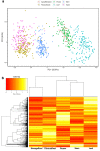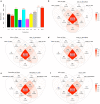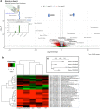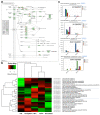A population based expression atlas provides insights into disease resistance and other physiological traits in cassava (Manihot esculenta Crantz)
- PMID: 34876620
- PMCID: PMC8651776
- DOI: 10.1038/s41598-021-02794-y
A population based expression atlas provides insights into disease resistance and other physiological traits in cassava (Manihot esculenta Crantz)
Abstract
Cassava, a food security crop in Africa, is grown throughout the tropics and subtropics. Although cassava can provide high productivity in suboptimal conditions, the yield in Africa is substantially lower than in other geographies. The yield gap is attributable to many challenges faced by cassava in Africa, including susceptibility to diseases and poor soil conditions. In this study, we carried out 3'RNA sequencing on 150 accessions from the National Crops Resources Research Institute, Uganda for 5 tissue types, providing population-based transcriptomics resources to the research community in a web-based queryable cassava expression atlas. Differential expression and weighted gene co-expression network analysis were performed to detect 8820 significantly differentially expressed genes (DEGs), revealing similarity in expression patterns between tissue types and the clustering of detected DEGs into 18 gene modules. As a confirmation of data quality, differential expression and pathway analysis targeting cassava mosaic disease (CMD) identified 27 genes observed in the plant-pathogen interaction pathway, several previously identified CMD resistance genes, and two peroxidase family proteins different from the CMD2 gene. Present research work represents a novel resource towards understanding complex traits at expression and molecular levels for the development of resistant and high-yielding cassava varieties, as exemplified with CMD.
© 2021. The Author(s).
Conflict of interest statement
The authors declare no competing interests.
Figures






Similar articles
-
Haplotype-resolved genomes of geminivirus-resistant and geminivirus-susceptible African cassava cultivars.BMC Biol. 2019 Sep 18;17(1):75. doi: 10.1186/s12915-019-0697-6. BMC Biol. 2019. PMID: 31533702 Free PMC article.
-
The VIRCA Project: virus resistant cassava for Africa.GM Crops Food. 2012 Apr-Jun;3(2):93-103. doi: 10.4161/gmcr.19144. Epub 2012 Apr 1. GM Crops Food. 2012. PMID: 22572842 Review.
-
Cassava molecular genetics and genomics for enhanced resistance to diseases and pests.Mol Plant Pathol. 2024 Jan;25(1):e13402. doi: 10.1111/mpp.13402. Epub 2023 Nov 7. Mol Plant Pathol. 2024. PMID: 37933591 Free PMC article. Review.
-
The early transcriptome response of cassava (Manihot esculenta Crantz) to mealybug (Phenacoccus manihoti) feeding.PLoS One. 2018 Aug 22;13(8):e0202541. doi: 10.1371/journal.pone.0202541. eCollection 2018. PLoS One. 2018. PMID: 30133510 Free PMC article.
-
Loss of CMD2-mediated resistance to cassava mosaic disease in plants regenerated through somatic embryogenesis.Mol Plant Pathol. 2016 Sep;17(7):1095-110. doi: 10.1111/mpp.12353. Epub 2016 Apr 5. Mol Plant Pathol. 2016. PMID: 26662210 Free PMC article.
Cited by
-
Evolutionary signatures of the erosion of sexual reproduction genes in domesticated cassava (Manihot esculenta).G3 (Bethesda). 2025 Feb 5;15(2):jkae282. doi: 10.1093/g3journal/jkae282. G3 (Bethesda). 2025. PMID: 39673428 Free PMC article.
References
-
- Food and Agriculture Organization of the United Nations . Save and Grow: Cassava: A Guide to Sustainable Production Intensification. Food & Agriculture Organization; 2018.
-
- Dixon AGO, et al. Fast track participatory approach to release of elite cassava genotypes for various uses in Nigeria’s cassava economy. Euphytica. 2008;160:1–13.
Publication types
MeSH terms
LinkOut - more resources
Full Text Sources
Research Materials
Miscellaneous

